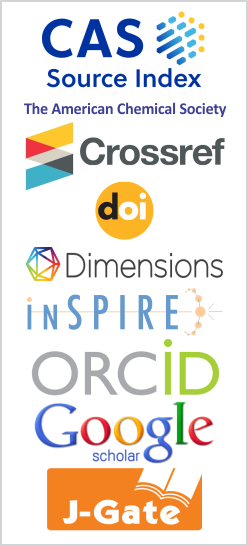Scattering of Electrons/positrons by H-atoms and H$_2$ Molecules under Weakly Coupled Plasmas
DOI:
https://doi.org/10.26713/jamcnp.v2i1.288Keywords:
Electron or positron scattering, Atomic and molecular hydrogen targets, eikonal-Born-series, Scattering cross sections, Screening by plasma, Debye screening lengthAbstract
In this paper we have examined the screening effects of weak Debye plasma on elastic scattering of electrons (e"’) or positrons (e+) by atomic as well molecular hydrogen at intermediate and high incident energies Ei ≥50 eV. The present theoretical work aims at investigating how plasma influences the angular and total scattering, in the background of free or no-plasma situation. The basic calculations are carried out in the 'eikonal-Born-series' (EBS) approach suitable for atomic hydrogen, along with the 'Independent Atom-in-Molecule' (IAiM) model for the H2 molecular target. Debye screening length ΛD is adopted as the parameter to assess the effect of the plasma environment on the scattering. Reduction in the forward differential cross sections (FDCS) and the total (complete) cross sections (TCS) is studied at typical values ΛD = 5, 7.5 and 10 Bohr radii a0. Our results show that, compared to the TCS, the FDCS are more sensitive to the plasma effects, for both H and H2 targets. Further for both these targets, differences between electron and positron scattering are also observed in our theoretical results.
Downloads
References
F.W. Byron and C.J. Joachain, Elastic electron-atom scattering at intermediate energies, Phy. Rev. A 8 1267 (1973).
C.J. Joachain, Quantum collision theory, North Holland Pub. (1983) and references therein
S.P. Khare, Introduction to the theory of collision of electrons with atoms and molecules, Kluwer Academic /Plenum Publishers (2001), and references therein
A. Jain, A.N. Tripathi and M.K. Srivastava, Phys. Rev. A 20 2352 (1979)
B.L. Jhanwar, S.P. Khare and M.K. Sharma, Phys. Rev. A 22 2451 (1980)
H. R. J. Walters, J. Phys. B: At. Mol. Opt. Phys. 21 1893 (1988)
K.N. Joshipura and S. Mohanan, Z. Phys. D-Atoms, molecules & clusters, 15, 67 (1990)
A. Ghoshal, M.Z.M. Kamali and K. Ratnavelu, Phys. Plasmas 20, 013506 (2008), and references therein
S. Nayek and A. Ghoshal, Eur. Phys. J. D 64, 257 (2011)
A.C. Yates, Phys. Rev. A 19, 1550 (1974); see also H. M. Modi, M. J. Pindaria and K. N. Joshipura, Prajna - J. Pure & Appl. Sci. (ISSN 0975 2595) 21 (2013-2014), 44.
D.P. Dewangan, J. Phys. B 13, L595 (1980)
P. Limao-Viera, R. Campeanu, M. Hoshino, O. Ingo'lfsson, N. Mason, Y. Nagashima and H. Tanuma, Eur. Phys. J. D 68 263 (2014)
Downloads
Published
How to Cite
Issue
Section
License
Authors who publish with this journal agree to the following terms:- Authors retain copyright and grant the journal right of first publication with the work simultaneously licensed under a CCAL that allows others to share the work with an acknowledgement of the work's authorship and initial publication in this journal.
- Authors are able to enter into separate, additional contractual arrangements for the non-exclusive distribution of the journal's published version of the work (e.g., post it to an institutional repository or publish it in a book), with an acknowledgement of its initial publication in this journal.
- Authors are permitted and encouraged to post their work online (e.g., in institutional repositories or on their website) prior to and during the submission process, as it can lead to productive exchanges, as well as earlier and greater citation of published work.




